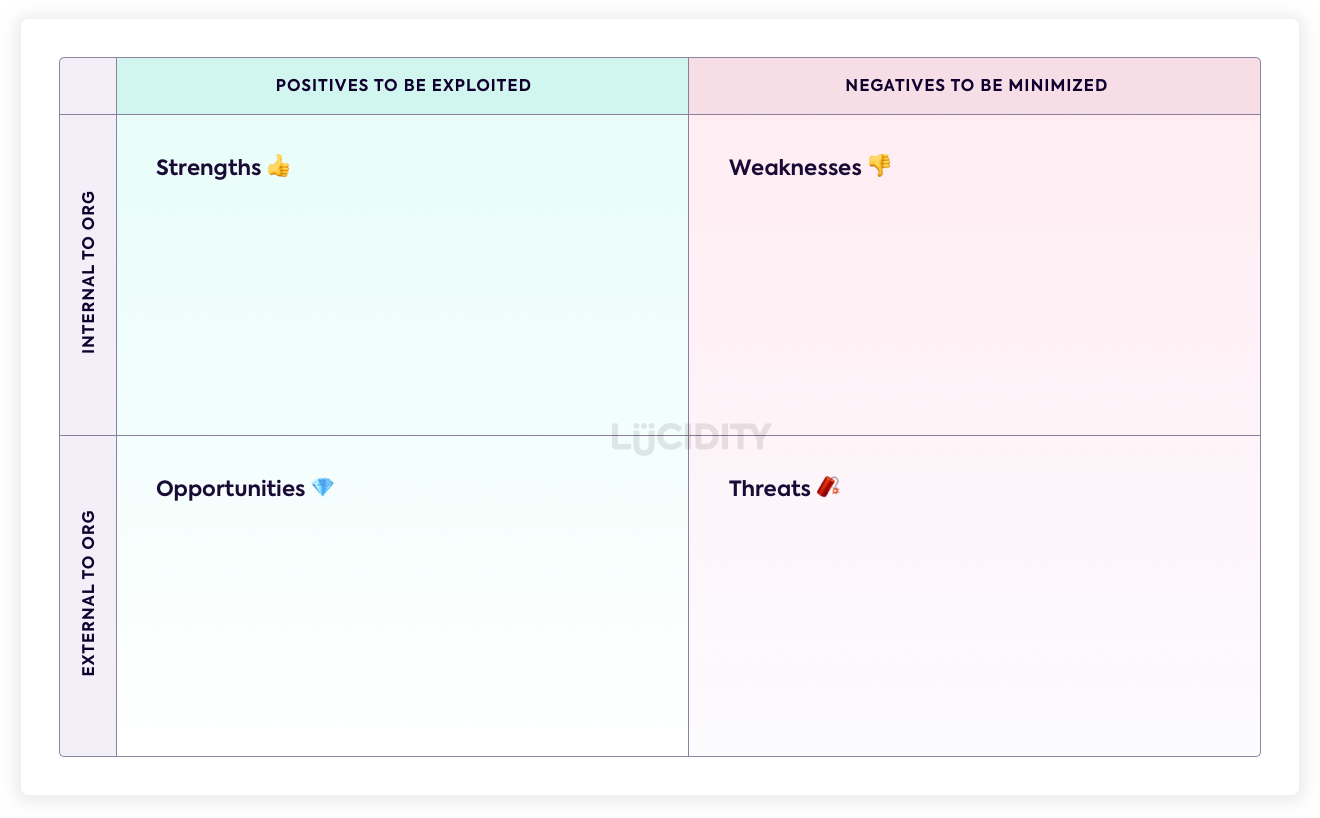Today we’re going to walk through developing the best SWOT for your business! Remember, if you’re new to SWOT check out our Introduction to SWOT Analysis before you read this.
SWOT analysis (alternatively SWOT matrix) is a structured planning method used to evaluate the strengths, weaknesses, opportunities and threats involved in a project or in a business venture. A SWOT analysis can be carried out for a product, place, industry or person.
It involves specifying the objective of the business venture or project and identifying the internal and external factors that are favourable and unfavourable to achieving that objective.
The technique is credited to Albert Humphrey, who led a convention at Stanford University in the 1960s and 1970s using data from Fortune 500 companies.
SWOT has been described as "a convenient visual framework for summarising what is known about an issue and identifying where gaps exist in knowledge" – Fink).
When you carry out a SWOT analysis, it’s basically a reality check on your business to make sure it is on the right track. It’s not a magic formula, but it can be a useful tool to help you find out where you are going, where you have been and how you might get where you want to go in the future.
It can be incorporated into strategic planning to discover potential opportunities and may be used in marketing plans.
What does SWOT Mean?
SWOT stands for Strengths, Weaknesses, Opportunities and Threats.
Strengths: What are your company’s strengths? These might include things like having a great location, great customer service or having industry expertise or knowledge.
Weaknesses: what are the areas where your business could improve? This might include weaknesses in areas such as cash flow management or marketing and sales.
Opportunities: What are the external factors that could provide your organization with a competitive advantage? This might include extending into new markets.
Threats: What are the factors that could harm your organization? This may include rising material costs, increasing competition or restricted supply of labor.
Almost every strategy development session uses SWOT analysis, much like salt in cookery. Used well it can enhance the rest of the strategy. Used badly it overpowers the rest of the process.
A well-done SWOT looks at your internal and external factors and can be an insightful and simple snapshot of what to consider when you’re developing your strategy.

Consider the SW part of the SWOT to be internal, so these lists will be populated by looking at your resources, your products, your internal processes, etc. Conversely, the OT part is external, so consider the wider market, what competitors are up to, any major changes in society, technology, legislation, etc.
1 – Always Start With Strengths
Brainstorm your strengths as a business and ensure a complete and detailed list. Place as many as possible, because you’ll be refining these later.
When conducting a successful SWOT analysis for your business planning, ensure you’ve taken into consideration all of the relevant factors including current and future business strategies.
It can often help to think of your client journey, all the touchpoints, and your sales messaging during this stage.
Example Generic Strength Areas:
- Brand recognition / value
- Supplier relationships
- Product feature set
- Skills
- Experience
- Client relationships
Helpful Questions:
- What’s your sales USP?
- Why will/do clients pick you over the alternatives?
- What are the backgrounds of your employees?
- How have you responded to market changes?
- What has been particularly successful for you and why?
- What are the owner profiles?
Once you’ve devised your strengths list it’s time to refine them. This involves removing duplicates, making sure you’re as specific as possible and ensuring that they are accurate.
A good SWOT will have a decent list of strengths but it won’t be so many that it becomes overwhelming. Take a step back and evaluate each one, is it really a strength that gives you an edge or value, or is it just something that is a decent BAU positive?
2 – Focus On Weaknesses
Now you have your Strengths complete, it’s time to focus on the weaknesses of the business. This is the mirror image to the Strengths and if you’ve been through the strengths process you should be able to quickly identify this list.
As with the previous entry, look at resources, the capabilities for the business and employees, your overall offering to the market.
Running the Weakness session often evokes people giving opinions rather than facts. This is helpful, as there may be information you can tease out of opinions, but it’s important to make sure you keep the SWOT unemotional and factual.
It’s also important to be specific, so for example if someone was to say “organisational design” is a Weakness, you need to understand why they believe that. Organisation design itself isn’t a weakness but there may be behaviour the org is showing, such as speed to respond, that the individual is attributing to org design.
Example Generic Weakness Areas:
- Single point of failures
- Speed of response
- Delivery quality
- Location
- Product lifecycle
- Skill sets
Helpful Questions:
- Look at a few customer complaints – what happened and why?
- Have you churned clients, if so why?
- What level of industry expertise do you have in the business?
- Where does it cost money to run the business?
- What’s your staff training plan?
As with the strengths, once you have your list it’s time to put some refinement into them. The same rules apply, you want to end up with a manageable, clear list that defines your core weaknesses in a way your team will fully understand. No duplicates, nothing too broad and no opinions.
3 – Review Internal Analysis
At this point you have a full SW analysis, giving you a picture of your internal business. You should have a refined list of Strengths and Weaknesses.
Take a step back and review both lists together, is there anything missing, or have you a complete picture of your internal workings?
If you’re happy it’s time to move on to the wider market.
4- Look For Opportunities
The OT is all about the future of the business, driving it forward and growing in ways that you had not previously considered. In order for this next section to be effective, it’s important to really understand the market you operate in, so if you’re doing this as a group make sure you include team members who are exposed to the market you operate in each day.
Make sure your Strengths list is easily accessible during this session as you should be referring to it in order to understand the potential.
Example Generic Opportunities Areas:
- Example product to new market
- Create new feature for new trend
- International expansion
- New transport/delivery options
- Market consolidation
- M&A
Helpful Questions:
- What are the technological trends impacting your clients?
- Would your product work overseas?
- Is there another market your products would work on?
- What problems can you solve with your skill-base?
- What do clients ask for?
- How do your Strengths and Weaknesses convert to Opportunities?
Refinement for Opportunities can come by identifying the key ones that would add value to the business. It’s important to recognise what is an Opportunity for the business vs what is correcting a fault. This is sometimes hard to define, for example, if there is no SLA in a company service team, is it an Opportunity to add it in, thus improving service, or not? There is no right or wrong answer, but the purpose of this is to propel the business forward, so consider BAU improvements as take-away key actions but not Opportunities.
5 – Identify the Threats
To identify the threats you must consider the external market, consumer trends, contingency plans, competitors, market share and your competitive advantage in the wider market.
Threats are items that may hit and negatively affect you outside of your control, so preparing for them and mitigating them is key.
Example Generic Threat Areas:
- Competitive activity in client base
- Internal skills changing with staff churn
- Trend changes within clients or technology
- Legal, political or social changes
- Economic climate and health of your suppliers
Helpful Questions:
- How is your product and service provided?
- Have you lost a client, if so to who?
- What is the spread of your revenue? Eg one key client?
- What trends will impact your product?
- Will your product or service be needed given the changes occurring?
You should now have a complete set of Threats born from considering the previous parts of the SWOT and your wider market. Once done, it’s time for the final refinement. The same rules apply, try to not be too broad, keep it factual and honest, and ensure you are thorough.
Now for two bonus steps to go the extra mile! 💪
6 – Taking Action
Once you’ve completed your SWOT it’s time to come up with the key actions. It’s surprising how often a SWOT is completed and not utilised to it’s full potential. The following actions should always be done:
Quick Wins:
There will be quick wins that can be actioned from your SWOT. It could be weaknesses that can quickly be removed, or opportunities you can rapidly take advantage on without any extensive changes. These should be allocated to a manager or employee and actioned.
Long Term:
A SWOT is part of a wider process, it’s given you a picture of the internal and external landscape. At Lucidity we’d recommend it’s used in conjunction with other tools as by itself it does not provide you with a full picture in order to successfully plan. However, if you have solely have done a SWOT then the longer term actions would be around how to mitigate your threats and take advantage of your opportunities. These will likely always form larger projects.
It’s helpful to take a look at the SOAR framework as one method of drawing conclusions from the SWOT.
7 – Re-using SWOT
Your SWOT analysis can be extended in the following ways:
-
Use as a foundation for future SWOTs. Each time you come to do your company SWOT, using your latest one as a SWOT analysis template saves time. Each point still needs to be discussed and agreed, and it’ll quickly become apparent if you’ve made progress
-
Competitor analysis SWOTs are often produced as a way to show your position against other companies.
We hope you found these steps helpful. You can access the full guide to SWOT or, to access more content and complete your own SWOT, sign up for Lucidity today!















